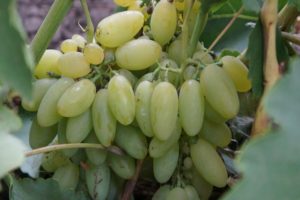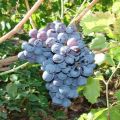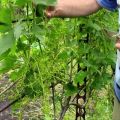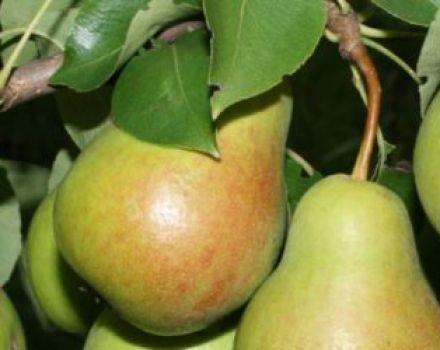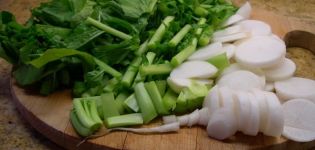Description of the Laura grape variety and characteristics of fruiting, especially cultivation and care
The juicy sweet berries of the Laura grape are widely known to many gardeners. The excellent taste with a light aroma of nutmeg has long been appreciated. An unpretentious shrub to care for, common in the southern and central regions of the country. Due to its numerous advantages, it is grown by ordinary summer residents, used in farms for sale, making wine.
Variety history
The name of the Laura variety is common mainly among amateur gardeners. The grapes are listed in the State Register under the name Flora. The hybrid was obtained in Odessa. In the course of crossing the varieties Husaine, Muscat de Saint Valier, Queen Tairovskaya, Muscat Hamburg. VE Tairov conducted selective experiments.
Description and characteristics
Each variety has specific data that determine the patterns of its development. Description of the distinctive characteristics of Laura grapes includes external features and characteristics of growth, fruiting of the plant:
- The grape shrub reaches medium size at maturity. Its main feature is a large number of fruitful shoots.
- Leaves of a standard shape are five-lobed. Depending on the degree of illumination, their color can be light or dark green.
- Laura's bunches are medium. Weight one to 1 kg. Under favorable weather conditions, good care, the figure can be increased to 2.5 kg. One bush yields a crop of berries of the same weight and size, even in an ordinary summer cottage.
- Laura's grapes at maturity become light, oval in shape. The weight of one berry is 7-10 g. The pulp is dense, juicy. Taste with a slight nutmeg undertone.
- The variety is considered early maturing. Flowering begins in May. The first crop is harvested in mid-August.
- One of the specific qualities of Laura is the excellent transportability of the fruit. They can withstand long journeys without harm to their appearance.
- Frost resistance - above average. The shrub can withstand temperatures down to 21-23 degrees.

Depending on the region of cultivation of the variety, the place of planting on the site, weather conditions, the quality of care procedures, the characteristics of the grapes can change both positively and negatively.
The Laura variety is a bright representative of the garden flora, popular among many summer residents and commercial gardeners.
Pros and cons of Laura grapes
Due to its many advantages, Laura grapes have long been in great demand for planting in garden plots:
- The shrub is characterized by abundant fruiting. 80% of the shoots give a crop.
- High resistance to most fungal diseases.
- Cold resistance allows breeding the variety in regions with winter temperatures down to -23 degrees.
- The ripe crop is well transported. This contributes to the long-term transportation of grapes over long distances.
- Large, sweet fruits.
- Early ripening of berries.
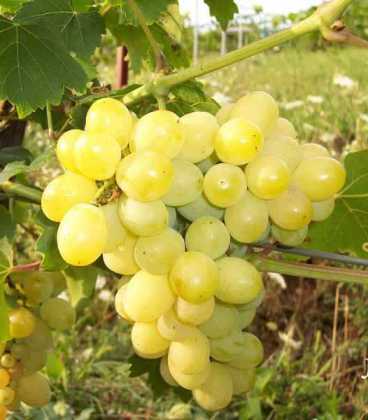
It is worth considering the specific feature of the Laura variety: there is a high risk of damage to shoots by powdery mildew. Timely prevention will minimize the risk of fungal infections.
Planting and ripening dates
The planting period for Laura grapes depends on the region, its climate, weather conditions:
- In the southern regions, landing can be made from October to March.
- For the middle lane, you should focus on a warm spring. The air temperature should not be lower than 17 degrees.
The rooting of the shrub should take place in the most comfortable conditions for the plant. It should be noted that the seedling must acclimatize, get used to the planting site before the onset of cold weather. The ripening period of the variety is considered short in comparison with other representatives of fruit and berry crops. The grapes are characterized by rapid growth.
Bloom begins in May. After the ovaries are formed. From this moment, no more than 120 days pass until the fruit fully ripens. The first crop is harvested in August, two years after planting. One bush brings up to 40 kg of delicious juicy berries. Grapes can remain on the shoots for a long time without dropping and without losing their taste.
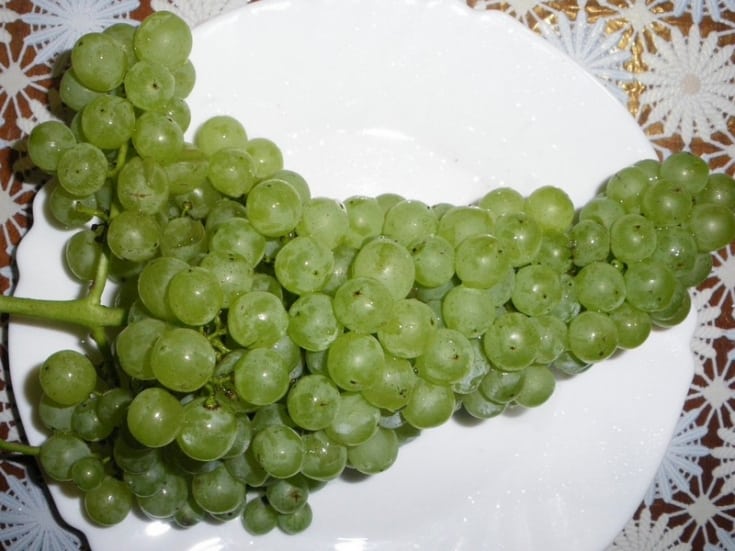
Planting tips
Planting Laura grape seedlings is a responsible procedure. When performing it, you should adhere to the recommendations of experienced gardeners:
- The soil should not be clayey. The increased salt content will lead to the death of the seedling.
- The variety prefers medium moisture. It is worth making sure that the groundwater is located at a distance of 1.5 m from the rhizome of the plant.
- Grapes love light. The landing site should be well lit.
- Shrubs need protection from wind and drafts.
Laura planting algorithm:
- The holes are prepared twice as much as the roots of the seedling.
- Pits at a distance of at least 1.5 m from each other.
- A mixture of soil and organic fertilizers is laid out at the bottom of the recess. Sprinkle ordinary earth on top.
- The seedling is lowered downward, spreading the roots. The root collar should be level with the surface. The pit is covered with soil. Lightly rammed.
- Watering is carried out. One bush consumes 2-3 buckets of clean water.
- The area around the trunk is mulched with straw, hay, sawdust.
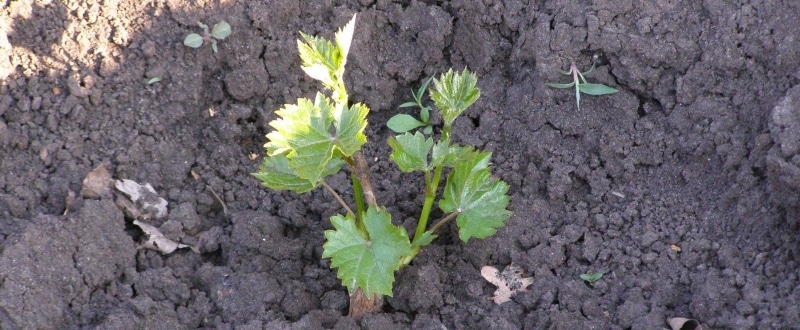
A young plant needs additional support. For this, a wooden stake is firmly installed in the pit with the seedling. The trunk is tied to it with a soft rope. After 2-3 years, the support can be removed.
Care rules
Caring for Laura grapes will not require significant time. The variety is quite unpretentious. To ensure high-quality growth and development, planting health, the following mandatory procedures should be followed:
- The plant needs regular watering. It depends on the weather conditions. In a hot period, the amount and frequency increase, in a wet, rainy period, they decrease. One adult bush takes about 3 buckets of water. Watering is carried out using special drainage pits. Grapes poorly absorb moisture directly under the stem. In autumn, the area around the trunk is mulched. This will help retain moisture in the soil.
- Fertilizing the plant is recommended often, but in small portions. Laura needs to be fed with potassium, phosphorus, magnesium. The introduction of drugs should be carried out depending on the phases of flowering, fruiting. During flowering and fruit ovary, the plant has a more intense need for additional nutrients. Before sheltering for the winter, the grapes are also fertilized. This will help him endure the cold season.
- Shrub pruning is carried out 2-3 years after planting. Cut off dry, damaged, overgrown shoots. For the full development of grapes, it is recommended to leave 3-4 main shoots. They will grow and get thicker. You should not get carried away with the formation of the crown of grapes. Laura can react badly to excessive pruning - to stop growing. Perform medium or short pruning.
- Shelter for the winter is a must. The variety is characterized by high resistance to frost, but low temperatures can damage fragile shoots. Young shrubs are bent to the ground, covered with earth. For older grapes, straw and hay are used. Do not cover the plant with materials that will not allow air to pass through.
- Prevention of plant diseases, insect pests should be carried out regularly and in a timely manner. The grapes are sprayed with special solutions, rotten fruits, dry leaves are removed from the territory, and all shoots are carefully examined.

Competent care is essential. High-quality watering, regular feeding, shelter for the winter, disease prevention will provide high immunity for Laura grapes. A healthy plant will yield a bountiful harvest of large, sweet berries.
Reproduction methods
The Lora grape is considered a "female" variety. Additional "male" species are needed for its pollination. It is best to use for this purpose:
- Arcadia;
- Kishmish Radiant;
- Rusball.
The Laura variety can multiply in several ways:
- Seeds. It is used to breed new varieties.
- Layering.
- Cuttings.
- Graft. Can be used on bushes, indoors.
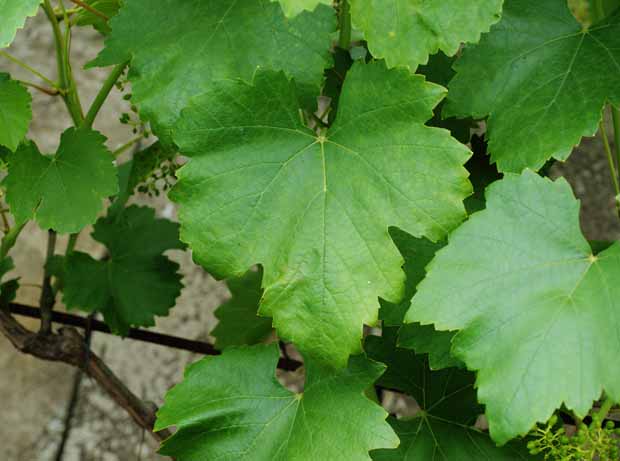
The most common breeding method is cuttings. The procedure is easy to follow if you follow simple rules:
- Cuttings are harvested just before the cold weather.
- The basis for harvesting should be a healthy, high-quality vine.
- The optimal length is 50-60 cm.
- Before storage, the cuttings are soaked in warm water for 2 days.
- After processing, they are wrapped in a damp cloth and placed in the refrigerator. The optimum temperature should be observed - 0-4 degrees.
- During the storage period, the cuttings are checked once a month. If the fabric dries, it must be re-moistened.
Before planting, the cuttings go through a number of mandatory stages:
- After wintering, the cuttings are checked. An incision is made on the trunk. If liquid comes out, then the young plant is ready for further processing. It happens that the seedling dries up. For rehabilitation, it is soaked for a longer period.
- Viable cuttings are dipped in warm water for several days.
- Rhizomes are treated with a special solution. It will speed up the process of root formation.
- The seedlings are dipped in sawdust for 10-15 days. Moisten them periodically. During this period, a young root system is formed.
- Germinate cuttings at home.
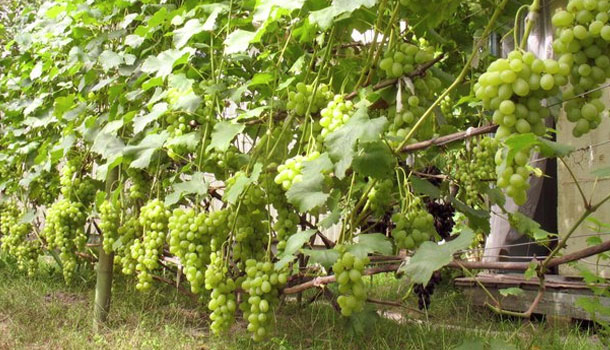
Further planting is carried out during the warm period. Subject to all the rules and regulations, the cuttings will take root in the prepared place.
Diseases and pests
The Laura variety has a high immunity against many fungal diseases. She is rarely affected by gray mold, mildew. A high level of danger to the grape bush is powdery mildew. For the prevention and treatment of such a disease, a number of mandatory measures are taken:
- Spraying with sulfuric solution. Laura is processed before flowering.
- The use of potassium permanganate. It is bred in water. A light solution is considered an excellent preventive measure. It is applied several times during the warm period. If the shrub is affected by oidium, then spraying is carried out more often.
- Mullein infusion is one of the popular folk remedies. Acts as a good way to prevent the onset of disease.
- In case of severe damage, it is recommended to use chemical preparations - "Karatan", "Rubiga", and others.
- Shrub processing is carried out with solutions of Bordeaux liquid, ferrous sulfate.
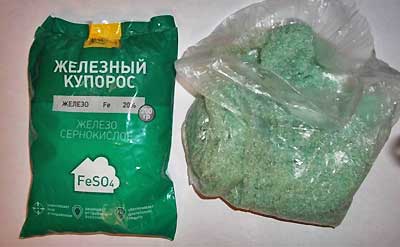
Laura berries are characterized by a high sugar content. This attracts many insect pests:
- Wasps. To protect against them, it is recommended to wrap each bunch with a special mesh. Bait, traps with poisonous agents - boric acid, "Karbofos" are placed not far from the landing.
- Birds. Small species of birds try to harvest ripe berries. To protect against them, use metal nets for bunches.
- Mice. Particular attention should be paid to the shoots covered for the winter. The mice gnaw at them. It is necessary to spread the burnt felt, wool between the grapes. Rodents will be repelled by the smell - they will not fit the grapes.
Treatment, prevention of plant diseases, the harmful effects of pests is an important component of the care procedures for Laura grapes.
A careful examination of the shoots, foliage, fruits of the plant will help to identify the disease at the stage of inception, and apply timely treatment measures.
The best regions to grow
Laura is a thermophilic plant. It is recommended to be planted in the southern regions of the country. The frost resistance of the plant makes it possible to cultivate the variety in central regions, cities with fluctuating low temperatures.
Laura variety is a well-known representative of fruit and berry crops. The excellent taste of grapes makes it a popular planting on the farm of many summer residents. Providing proper care will be the basis for regular, abundant fruiting. The undeniable advantages of the shrub give it a leading position in modern gardening.
